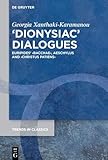›Dionysiac‹ Dialogues : Euripides' ›Bacchae‹, Aeschylus and ›Christus Patiens‹ / Georgia Xanthaki-Karamanou.
Material type: TextSeries: Trends in Classics - Supplementary Volumes ; 128Publisher: Berlin ; Boston : De Gruyter, [2022]Copyright date: ©2022Description: 1 online resource (XXIII, 264 p.)Content type:
TextSeries: Trends in Classics - Supplementary Volumes ; 128Publisher: Berlin ; Boston : De Gruyter, [2022]Copyright date: ©2022Description: 1 online resource (XXIII, 264 p.)Content type: - 9783110764345
- 9783110764499
- 9783110764413
- online - DeGruyter
- Issued also in print.
| Item type | Current library | Call number | URL | Status | Notes | Barcode | |
|---|---|---|---|---|---|---|---|
 eBook
eBook
|
Biblioteca "Angelicum" Pont. Univ. S.Tommaso d'Aquino Nuvola online | online - DeGruyter (Browse shelf(Opens below)) | Online access | Not for loan (Accesso limitato) | Accesso per gli utenti autorizzati / Access for authorized users | (dgr)9783110764413 |
Browsing Biblioteca "Angelicum" Pont. Univ. S.Tommaso d'Aquino shelves, Shelving location: Nuvola online Close shelf browser (Hides shelf browser)
Frontmatter -- Preface -- Contents -- Abbreviations -- List of Figures -- Introduction: Aims and Scope -- 1 The Dionysiac Plays of Aeschylus and Euripides’ Bacchae -- 2 Euripides’ Bacchae and Christus Patiens -- Appendix I: Evidence for Aeschylus’ Dionysiac Plays -- Appendix II: Main Vases Related to the Dionysiac Plays of Aeschylus -- Appendix III: Christus Patiens as a Source for the Missing Part in the Exodos of Bacchae -- Αppendix IV -- Bibliography -- Index Rerum -- Index Locorum -- Index of Hapax and Rare Words in Aeschylus’ Dionysiac Tetralogies
restricted access online access with authorization star
http://purl.org/coar/access_right/c_16ec
This book consists of two main, interrelated thematic units: the reception of Aeschylus' Dionysiac plays in Bacchae and the refiguration of the latter in the Byzantine drama Christus Patiens. In both sections the common denominator is Euripides' Bacchae, which is approached as a receiving text in the first unit and as a source text in the second. Each section addresses dramatic, ideological and cultural facets of the reception process, yielding insight into pivotal Dionysiac motifs that the ancient and Byzantine treatments share. Different pieces of evidence, mythographic, stylistic, and iconographic, are interrogated, so that light is shed on aspects of the storyline, the concepts, and the imagery of Aeschylus' two tetralogies. At the same time, Bacchae provides a valuable exemplum for aspects of dramatic technique, plot-patterns, and concepts refigured in Christus Patiens. This exploration thoroughly and systematically focuses on the ways in which the pagan play was transformed to bring forward new pillars of thought and innovative values in different cultural and ideological contexts over a wide time span from Greek Antiquity to Byzantium.
Issued also in print.
Mode of access: Internet via World Wide Web.
In English.
Description based on online resource; title from PDF title page (publisher's Web site, viewed 02. Mai 2023)









